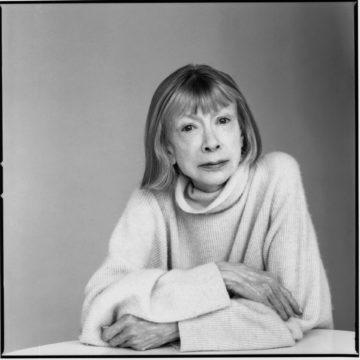Nathan Heller in The New Yorker:
 When Joan Didion died, on Thursday, at eighty-seven, she left behind sixteen books, seven films, one play, and an impulse to make sense of what remained. It was tempting to note that, like her husband, the writer John Gregory Dunne, whose passing shaped “The Year of Magical Thinking” (2005), she died during the Christmas holiday. It was easy to see, as she did in her daughter’s lethal illness that same season, larger gears at work. Didion was a pattern-seeker—a writer with an uncanny ability to scan a text, a folder of clippings, or an entire society and, like a genius eying figures, find the markers pointing out how the whole worked. Through her efforts, the craft of journalism changed. She helped expand the landscape of what matters on the page.
When Joan Didion died, on Thursday, at eighty-seven, she left behind sixteen books, seven films, one play, and an impulse to make sense of what remained. It was tempting to note that, like her husband, the writer John Gregory Dunne, whose passing shaped “The Year of Magical Thinking” (2005), she died during the Christmas holiday. It was easy to see, as she did in her daughter’s lethal illness that same season, larger gears at work. Didion was a pattern-seeker—a writer with an uncanny ability to scan a text, a folder of clippings, or an entire society and, like a genius eying figures, find the markers pointing out how the whole worked. Through her efforts, the craft of journalism changed. She helped expand the landscape of what matters on the page.
Though Didion spent half her life in New York (first as a junior editor at Vogue, then, in a later stint, as a short-statured lioness of letters), much of her best-known work was done in California, where she’d grown up in mid-century Sacramento. Her ominous, valley-flat style channelled the Pacific terrain, with its beauty and severity and restless turns. “This is the country in which a belief in the literal interpretation of Genesis has slipped imperceptibly into a belief in the literal interpretation of Double Indemnity, the country of the teased hair and the Capris and the girls for whom all life’s promise comes down to a waltz-length white wedding dress and the birth of a Kimberly or a Sherry or a Debbi and a Tijuana divorce and a return to hairdressers’ school,” she wrote in “Some Dreamers of the Golden Dream,” the essay that opened her first collection, “Slouching Towards Bethlehem” (1968). That book announced her subject—the long, crazed shadow of the frontier mentality—and her style, which carried across five novels and several screenplays, not least “A Star Is Born” (1976), which she co-wrote with Dunne. Today, readers know what’s meant by “Didionesque.”
Like most strong stylists, though, Didion worked up her craft as a sensitive reader of other masters. She had been an English student, at Berkeley, in the nineteen-fifties, a high point for the New Criticism and its close reading, and the approach became part of her lifelong methodology, applied equally to language she encountered as a reporter and to literary work. In a New Yorker essay about Hemingway, her early influence, she performed an unmatched reading of the beginning of “A Farewell to Arms,” noting how the sudden, pattern-breaking absence of a “the” before the third appearance of “leaves” casts “exactly what it was meant to cast, a chill, a premonition.” It was characteristic of Didion to work this way, in the danger zone between sensibility and objectivity: to be receptive to a passing feeling, a change in cast, and then to bear down, with unsparing rigor, in the work of understanding why.
More here.
